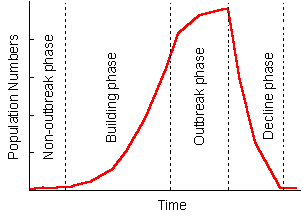Ecological Mechanisms of Outbreaks
Population outbreaks are characterized by rapid change in population density over several orders of magnitude. Only a small number of species have outbreaks: e.g., some insect pests, pathogens, and rodents. Population outbreaks often cause serious ecological and economic problems. Examples of outbreak species: locusts, southern pine beetle, spruce budworm, gypsy moth
Two kinds of outbreaks:
1. Introduction of a species to a new area
2. Growth of a native population.
The second case is most interesting because it is important to understand why a population suddenly increases in its density. Usually an outbreak goes through the following phases:

Initially ecologists tried to explain outbreaks by direct impact of environmental factors. However, the magnitude of change in these factors was always much smaller than the magnitude of change in population density. Attempts to find a "releasing factor" usually fail.
Thus, there should be an "amlipier" of a small initial disturbance.
Examples of "amplifiers":
1. Inverse density-dependence (positive feedback)
- 1.1. Escape from natural enemies: gypsy moth.
- Mortality caused by generalist predators with a type II or III functional response decreases with increasing prey density. Thus, the greater is the population density, the faster it grows. Escape from natural enemies may also result from a delay in the numerical response of natural enemies (pine sawflies, gypsy moth).
- 1.2. Group effect: bark beetles, sawyer beetle (Cerambicidae), locusts.
- Bark beetles succeed in attacking a healthy tree only when the number of beetles is large. Adults of the sawyer beetle, Monochamus urussovi, feed on small branches of Siberian fir. When the density of adults is high, then they cause considerable damage and the tree looses its resistance to developing larvae of this species. Locusts change their behavior at high population density, and their reproduction rate increases.
- 2.1. Plant response to disturbance: spider mites.
- Population of spider mites grow very fast at high temperature. They live on plant leaves where local temperature is lower than the ambient temperature. During the draught, plant transpiration is reduced, and thus, the temperature of leaves increases causing rapid reproduction of spider mites.
- 2.2. Insect physiological response to disturbance: sawflies.
- Pine sawflies, Diprion pini, have >50% of their population in a prolonged diapause lasting from 1 to 5 years. Draught may cause reactivation of a large proportion of diapausing sawflies. This effect is combined with subsequent escape from natural enemies.
Outbreaks collapse usually due to one of the following mechanisms:
- Destruction of resources
- Natural enemies
- Unfavorable weather


